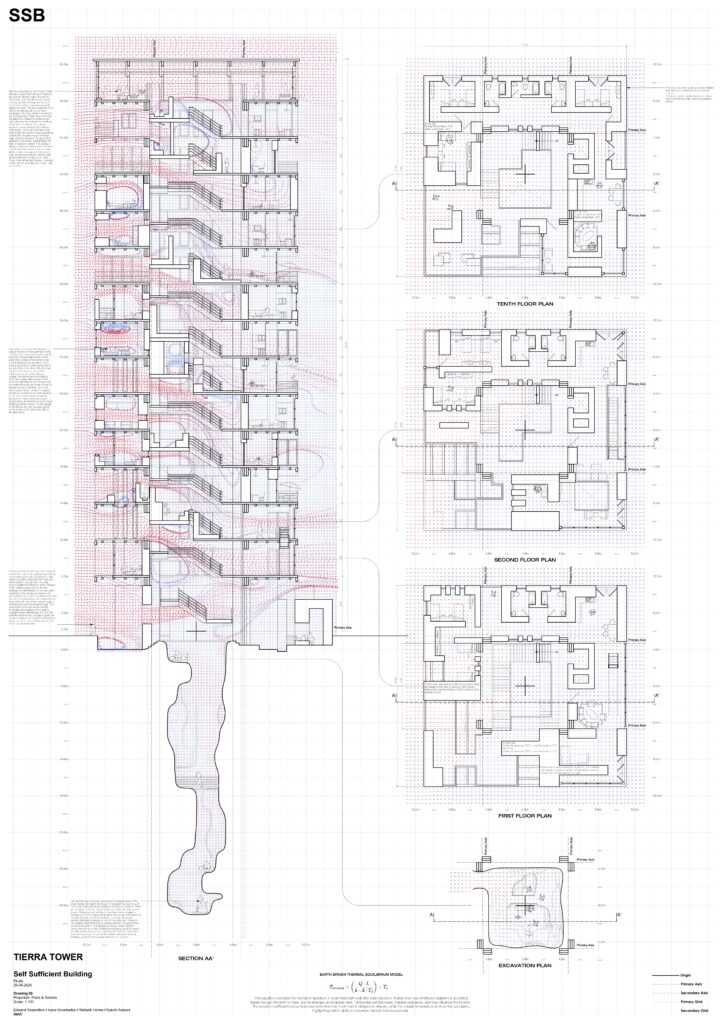Tierra Tower is a student housing project shaped by climate and material. Using earth sourced directly from site, it creates a vertical sequence of spaces that adapt to seasonal change and personal comfort. Thick earthen walls absorb and release heat, guiding movement through warm and cool zones. The building responds passively—through texture, temperature, and atmosphere—to how people live.
First impressions
Cardona’s first look of his new home threw his head back, in spectacle, gazing completely up at the towering structure laid before him. But unlike most tall buildings this didn’t resemble that of tradition, nor any other university accommodation he’d been to before. Situated in the Poblenou area, close to his new university, the slenderness of the tower didn’t equal that of the massive elements which proceeded to sit on each floor all the way to the top. As he moved closer to the entrance these huge walls didn’t get smaller instead began to encapsulate him as he entered through. The texture becomes more visceral and the immediate acknowledgement of earth is apparent, these walls emerge him within the cave like structure which sought to guide him towards a large atrium. A gust of wind took him by surprise as he peeped down into the hole which caved in below him.
Verticality of Earth
Earth as phenomena
Why Earth?
he Earth absorbs, delays, and releases heat, forming the basis for thermal comfort and environmental modulation through mass.
Earth driven thermal equilibrium model
This equation describes the internal temperature of a rammed earth wall after solar exposure. It describes how shortwave radiation is absorbed, travels through the earth’s mass, and re-emerges as longwave heat. Factors like wall thickness, material resistance, and time influence this transfer. The sorption coefficient and surface area determine how much heat is delayed or retained, while the outside temperature anchors the calculation, highlighting earth’s ability to moderate internal climates passively.
0KM Sourcing
Our intention towards 0 kilometre extraction presented us with a challenge to identify how we could apply our phenomenology with the context of deep underground excavated spaces
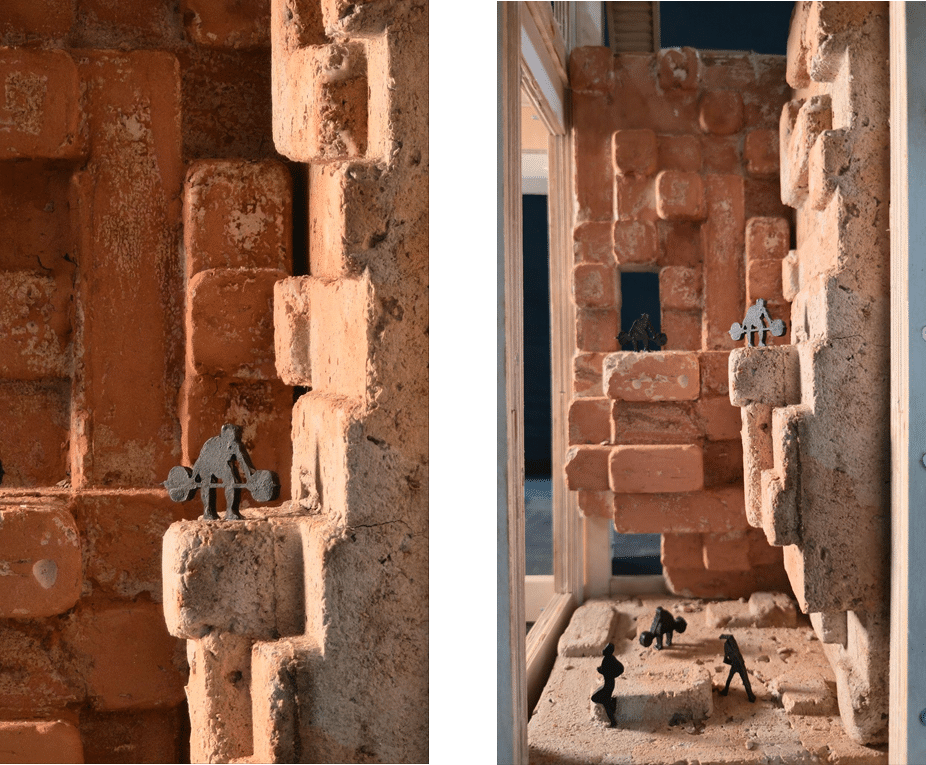
Earth being an abundant material we wanted to know what that meant for a project that takes its raw materials directly from site. Our intention towards 0 kilometer extraction presented us with a challenge to identify how we could apply our phenomenology with the context of deep underground excavated spaces and elevate the relationship between the lower and upper scale of the site. Determined by the volume of earth we have cultivated for the tower we sink this space down 30m meeting the full requirements of our material usage. We acknowledged that our earthen phenomena can take on an even greater role in this space changing the quality of how the spaces function to the upper floors.
Phenomena described though structure
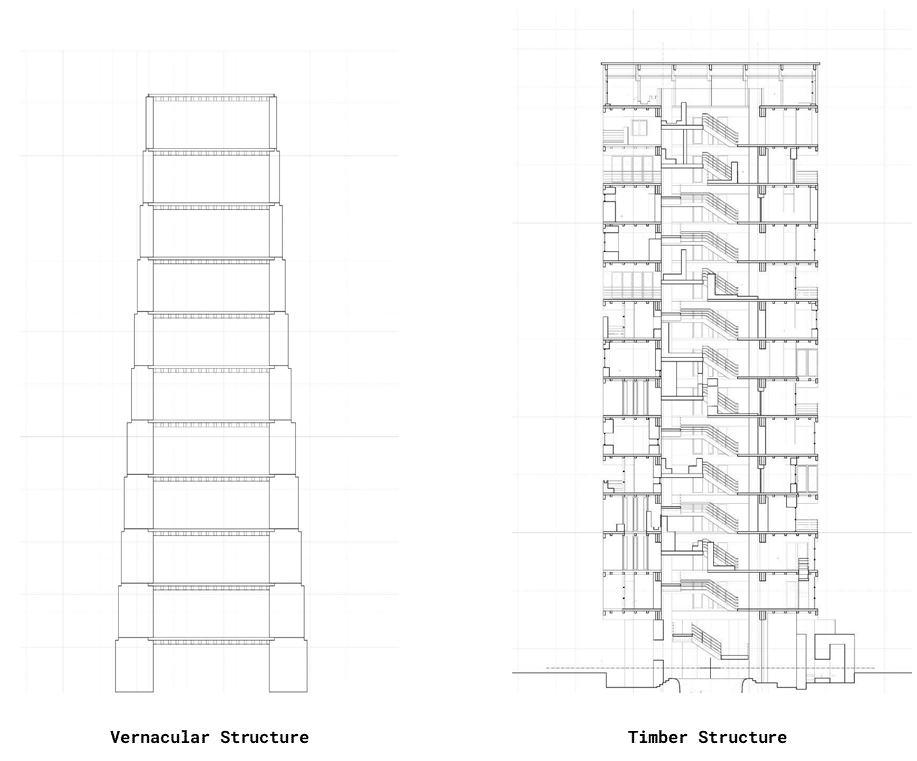
Traditionally Earth structures for centuries if not millennia have conformed to the practice of growing walls from a thick base and gradually thinning as it reaches tall heights. This practice works well structurally and has many advantages including its ease to make, structural continuity and has the ability to transfer its radiative conduction across multiple floors. Although a tower to this scale would be a huge undertaking with this structure, a question raised is how we may give priority to the way in which our phenomena could be created. Vernacular structure would shoehorn us into a structure that wouldn’t have flexibility floor to floor to create spaces truly free from thew constraints of structure. We decided to incorporate a more modern solution by using the Earth more as phenomenological in nature as opposed to purely structural.
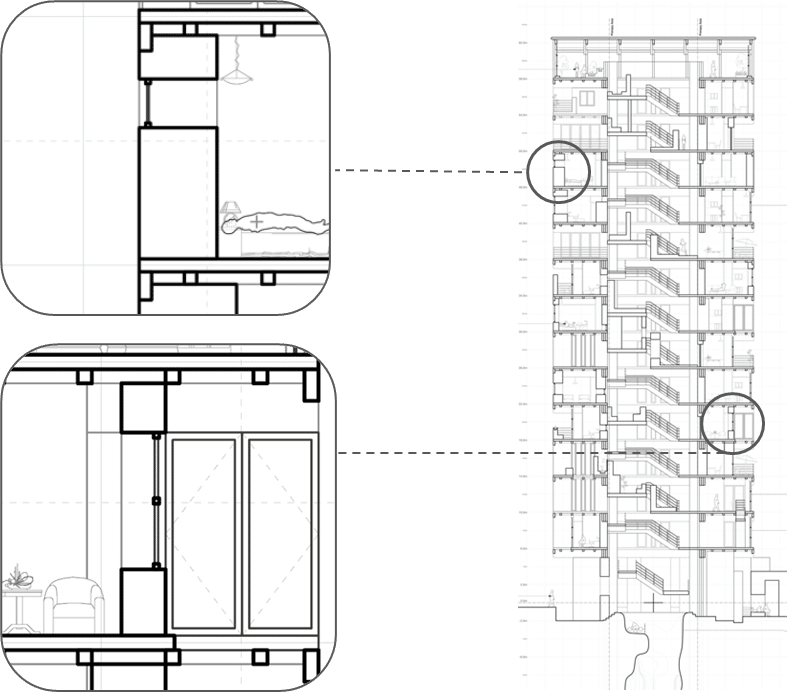
A great example of how we have exercised this within our project is shown in the reversal of vernacular block location. Putting some of our thickest blocks to the uppermost parts of our tower we can expose these blocks to the greater solar radiation, climatically creating greater thermal lag through our blocks and cooled spaces during the peak day. Locating a set of thin wall towards the bottom shows how the flexibility of this structure alleviates any pressure from creating the adaptable climates we aim to condition within our project.
Comfortability through space

Comfort described through mapped earth phenomena
Mitu catches her breath after deciding to scale all the floors to her apartment on the 11th floor. She shoves her way through the door and is immediately relieved by the welcoming coolness of the entrance hall. But still exhausted she decides to move towards her bedroom where at this time of day will still be at its coldest. Brushing her hand up to the wall she can feel the coldness of the Earth wall. Always a surprise considering the almost blazing 32°C heat outside. After resting for few hours the walls begin to warm in her room, she prefers the more temperate climate, so decides moving to the living room is the best course of action, by now this space would have cooled and the earth adjusted the thermals down to what she prefers, although her housemates have argued against doing just quite the opposite always preferring warmer spaces. A smile appears on her face as she can now read a book by the window of the living room without any disturbance.
Phenomena to the body
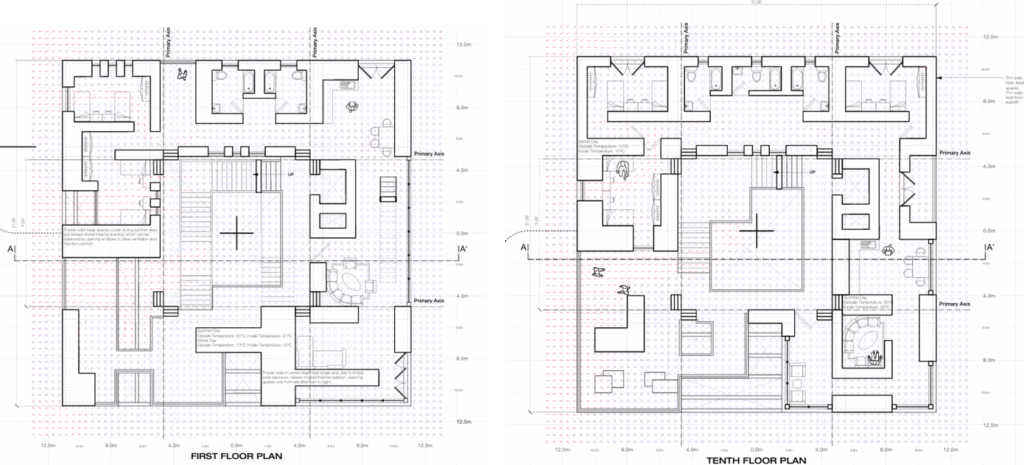
As time passes through our spaces the internal fluctuation of warming and cooling prescribes extremities that dictate the movement of perceived comfortability through the building
Throughout the year, ventilation becomes a tool for modulation. Opening windows allows cross-ventilation, carrying warm air into parts of the building not directly affected by solar gain, or conversely, cooling overheated areas by exposure to cooler thermal mass. This passive strategy forms a dynamic thermal ecosystem, where comfort is not fixed to uniform temperature, but emerges from the interplay of material behavior, spatial sequencing, and occupant adaptation. Comfort becomes a lived phenomenon, continuously shaped by the building’s interaction with climate and the user’s movement within it.
Robotic Sun Path simulation
As seasonal temperatures shift, the spatial behavior of occupants adapts to the thermal response of the material. During summer, thicker walls delay the transmission of external heat, maintaining cool interior conditions through the day. As the thermal lag causes the stored radiation to be released into the interior by late afternoon and evening, occupants may shift to more ventilated or shaded areas, opening windows to expel warm air and draw in the cooler exterior climate. This movement aligns with daily thermal cycles, promoting comfort through passive adaptation. During the winter, the same thick walls release significantly less heat, as solar gain is minimal. Spaces remain cooler throughout the day, with slight warming occurring only in the late afternoon. Occupants naturally gravitate toward thinner-walled or sun-facing zones, which absorb and release solar energy more rapidly, delivering a short burst of warmth in synchrony with the reduced winter sun. Closing windows in this period helps retain the limited heat, allowing spaces to thermally stabilize. This lies in strong contrast to the climatically unaffected space that sits as a reflection of our building underground.
Under the Earth
Experiencing the climatically unaffected space
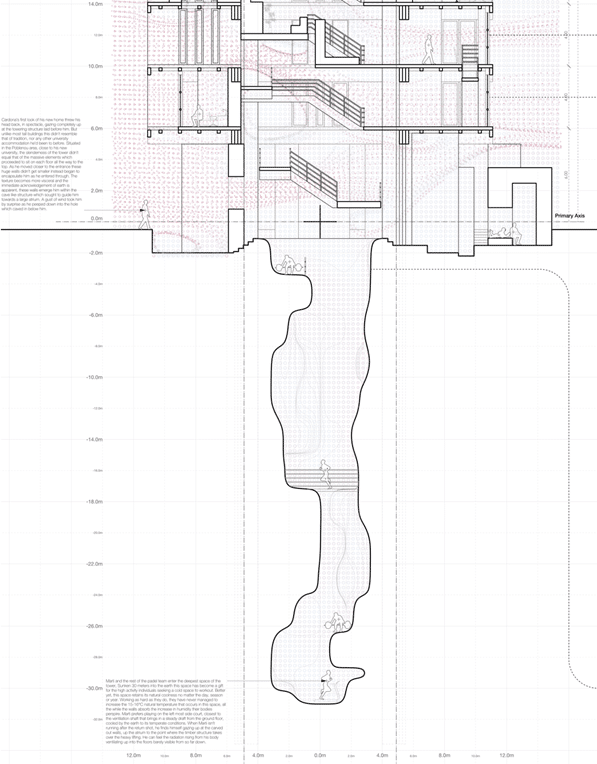
Marti and the rest of the padel team enter the deepest space of the tower, Sunken 30 meters into the earth this space has become a gift for the high activity individuals seeking a cold space to workout. Better yet, this space retains its natural coolness no matter the day, season or year. Working as hard as they do, they have never managed to increase the 15-16°C natural temperature that occurs in this space, all the while the walls absorb the increase in humidity their bodies perspire. Marti prefers playing on the left most side court, closest to the ventilation shaft that brings in a steady draft from the ground floor, cooled by the earth to its temperate conditions. When Marti isn’t running after the return shot, he finds himself gazing up at the carved out walls, up the atrium to the point where the timber structure takes over the heavy lifting. He can feel the radiation rising from his body ventilating up into the floors barely visible from so far down.
Internal Radiation through exertion

The high exertive usage of our extraction site argues another relationship between the lower and upper parts of our student tower. We want to understand how simulating this environment within an experimental model at 1:10 scale, would showcase our phenomena from an internally climatic provocation. The atrium serves to transport this phenomenon to the upper levels. The movement of air through our ventilation shaft provides additional airflow inducing further rise of humidity and radiation as demonstrated with the steam plate in our experimentational model. Later acting to cool the service stairs and communal corridors that surround the atrium space.
Verticality through space
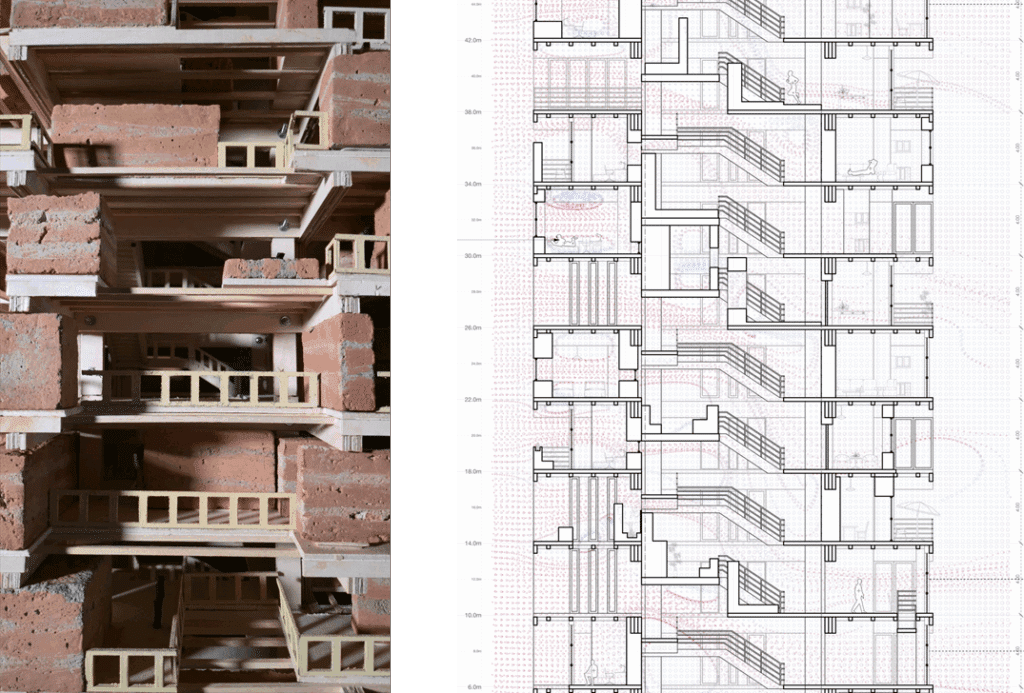
To create cold and hot spaces. The environmental conditions depict the universally accepted comfortable spaces. However, in an attempt to create these spaces, so we will also create environmentally juxtaposed spaces, some people may prefer these cooler or warmer conditions, with personal preference taking charge. The seasons control where these conditions occur, however by bringing in the external winds, we can cross ventilate the building from the highest radiated side, transferring climatically warmed or cooled air dependent on.
Architectural principles
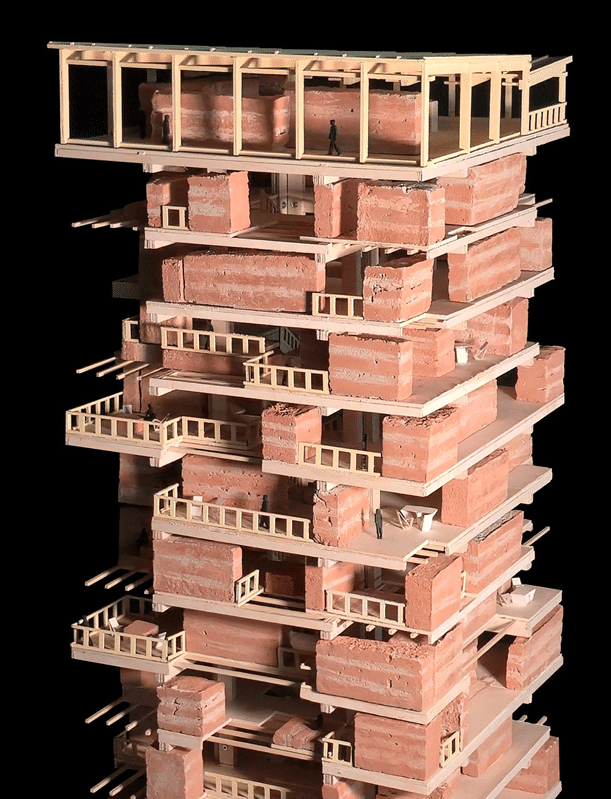
We develop our methodology of personal preference defining space through intentional placement and phenomenologically adapted movement. Designing floors that are climatically warmer and spaces that are climatically cooler, working off each other where specific temperatures cannot be met, using cross ventilation in cases and internal atrium usage in others. Producing tight corridors to compress sound and temperature, while amplifying the sensation of touch and enclosure. wider openings allow ventilation to flow more freely, these spaces then become generally cooler functioning more as communal. Bedrooms are designed to release heat later into the night to provide warmth and living rooms and kitchens warm more rapidly taking advantage of the morning sun. The thickness of these blocks remain crucial to gaining the types of conditions desired on each space, demanding a calculation of the sun path and of our formulaic analysis. Movement through the tower is driven by these temperature gradients, guiding occupants to areas that align with their personal comfort needs. In this way, climate and material logic define how space is experienced, organized, and inhabited.
The Last Day
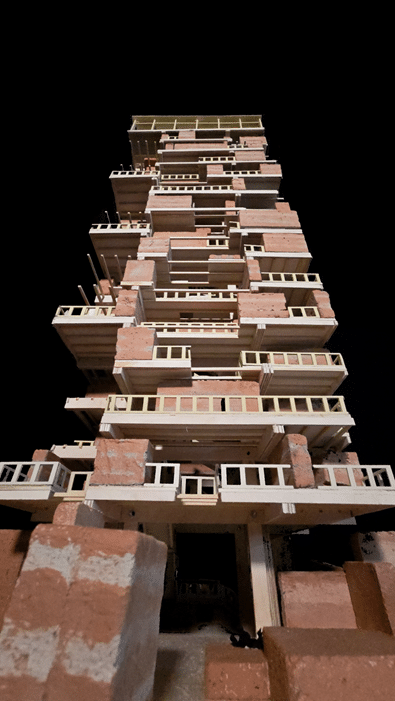
After two years living in Tierra Tower, Farrah decides to spend her final day immersed in the spaces that have quietly shaped her. She begins on the familiar terrace, where morning light filters through and the cool touch of her earthen chair presses gently against her back. The day is expected to be one of the warmest yet, so she takes advantage of the early breeze to ascend to the rooftop terrace. There, she sits among the plants that offered her a calm refuge during the pressure of deadlines, breathing in the elevated stillness. Her journey upwards is punctuated by tight corridors softened by floor-to-ceiling windows that usher in light and warmth, creating gentle air currents that circulate through the tower. Later, she joins friends on the ground floor, gathered on excavated seating beside the café, shaded and relaxed. The building’s design—flexible and responsive—comes to mind. It offered her choice: hotter climates below, cooler ones above. In her second year, she embraced thicker, earthen walls that insulated her from the world. Tierra Tower never demanded change—it adapted to her rhythms, grounding her in earth, light, and season.
